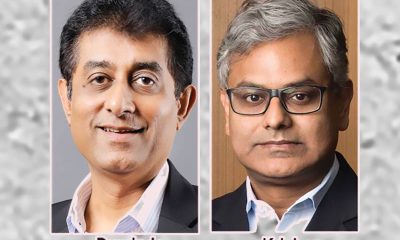Opinion
A TRIBUTE TO A WONDERFUL FRIEND

Mirani, your demise has brought us tremendous grief. During your lifetime you fulfilled all your duties and obligations with graciousness and generosity combined with love and compassion. This was not surprising as you came from a philanthropic family, the Salgados from Panadura.
Your service to humanity is appreciated by everyone who knew you. The Kandy Cancer Society and the Kandy Horticulture Society are two organizations that received your unwavering support. The guidance, care, love and inspiration you showered upon the residents of the Mulgampola Home for Elders of which you were President, is yet another example of your humane and benevolent nature. These are but a few of the activities you were involved in wholeheartedly. As the Buddha proclaimed, neither fire nor wind, birth nor death, can take away your many good deeds. Your life was a garland of service to others. You never wanted your many activities to be noticed but those who were fortunate enough to know you, observed and appreciated your very generous personality.
The impact you had on your neighbourhood at Siebel Place, Kandy,where you lived for decades, was immense. You were the nucleus around which much of the social life revolved. The few years, in the 1970s, that my family and I lived next door to you, resulted in a lifelong friendship which I will cherish for the rest of my days. You made our lives richer. We were the fortunate recipients of your compassion, loving kindness and sympathetic joy. Our children, now adults, who are scattered all over the world, will always remember you with love and gratitude, not least for all the special treats you showered on the.
It is impossible to do justice to who you were, in this brief appreciative tribute. All the merit you acquired in this life, no doubt, would lead you on the path to eternal bliss.
My deepest sympathies go out to your four children, Wimal, Anoja, Menaka and Suren, who grew up with such grace and dignity.
Dear Mirani, the song has ended but the melody lingers on………
May you attain Nibbana!
Ruky
Opinion
What is research? Why do research and for who’s benefit?

Longitudinal research programme for biofertiliser at NIFS: impact and impact pathways for peoples benefit
The National Institute of Fundamental Studies (NIFS), formerly the Institute of Fundamental Studies (IFS), dedicated to fundamental and advanced research, was stablished by an Act of parliament in 1981 under the leadership of the late President J. R. Jayewardene. Inspired by Prof. Cyril Ponnamperuma and Prof. Chandra Wickramasinghe. Beginning, it was located in a small office in Colombo before evolving into a comprehensive research institute located in Kandy.
Prof. Chandra Wickramasinghe, a prominent Sri Lankan-born astrophysicist and mathematician affiliated with Cardiff University, UK, advocated for establishing a scientific research institution in Sri Lanka dedicated to fundamental science and global scientific advancement. He served as the founding Director of IFS. Similarly, Prof. Cyril Ponnamperuma, a renowned Sri Lankan-born scientist and astrobiologist at the University of Maryland, USA, devoted himself to establishing a research institute in Sri Lanka to foster scientific excellence and collaboration. His international reputation was instrumental in gaining support for IFS.
This article aims to highlight NIFS’s broader contributions. Recognising the complexity of its history, a recent initiative under Senior Prof. Lakshman Dissanayake’s leadership—a 200-page coffee table book—documents NIFS’s proud achievements comprehensively. This publication reflects NIFS’s enduring legacy and its pivotal role in shaping scientific discourse in Sri Lanka and beyond.
Fundamental studies, also known as basic research, focus on exploring fundamental principles, theories, or concepts within a specific field. They aim to establish a solid understanding of underlying principles that form the basis of a discipline, often driven by curiosity.
Advanced studies, on the other hand, delve deeper into a field beyond foundational knowledge. While fundamental studies lay the groundwork, advanced studies build upon this foundation, though the terms can vary in usage and may not always be interchangeable.
Applied research, distinct from both fundamental and advanced research, addresses practical problems or issues in real-world contexts, aims to generate solutions or improvements with immediate applicability, enhancing processes, products, or services and focuses on practical outcomes that directly benefit society or industry, distinguishing it from the theoretical focus of fundamental and advanced studies.
Outcomes from research projects usually focus on contributing new knowledge to academic or scientific communities, often through publications in scholarly journals. In contrast, research programmes may lead to broader impacts, including policy changes, improvements in service delivery, or other tangible benefits for targeted populations or sectors.
One exemplary case illustrating these concepts is the evolution of the Biological Nitrogen Fixation (BNF) Project at the National Institute of Fundamental Studies (NIFS) in Sri Lanka. Initiated under the directorship of Prof. Ponnamperuma, the BNF Project commenced with the recruitment of Prof. S. A. Kulasooriya in 1983. During the initial years, as Prof. Ponnamperuma secured resources and transformed the Hantane Hotel into a research institute, the project faced challenges but persisted with support from the Japanese International Cooperation Agency (JICA).
Initially funded by a grant from the United Nations University, the BNF Project started laboratory studies with three research assistants who later pursued postgraduate studies abroad. After a brief hiatus, collaboration with the Catholic University of Leuven, Belgium, revitalised the project under Prof. Kulasooriya’s leadership, culminating in several local researchers earning postgraduate degrees. The collaboration concluded successfully in 1997.’
Dr. Gamini Seneviratne’s entry marked a significant shift towards studying non-symbiotic microbial associations with plants—a more advanced research direction. His pioneering work identified biofilm formations among beneficial microbes, leading to the concept of biofilm-based biofertilizers (BFBF) introduced globally by NIFS in 2003. Subsequent research confirmed the efficacy of BFBFs in reducing chemical fertiliser usage while increasing crop yields, prompting patent acquisition and further studies on their agricultural applications.
The success of the BFBF research prompted the establishment of the Microbial Biotechnology Unit (MBU) at NIFS, consolidating ongoing projects under a unified framework. By 2009, field trials with the Tea Research Institute aimed to halve chemical fertiliser use, showcasing the practical impact of NIFS’s research endeavors on sustainable agriculture.
In summary, the journey from the BNF Project to the MBU exemplifies how research projects can evolve into comprehensive programmes that address complex challenges through innovative scientific approaches. NIFS’s contributions in microbial biotechnology highlight its pivotal role in advancing sustainable agriculture and fostering scientific excellence in Sri Lanka and beyond.
‘Samantha Kumarasinghe, a former science graduate from the University of Peradeniya, saw the potential of Biofilm-Biofertilizer (BFBF) technology and acquired its patent. He established Lanka Bio-Fertilizers (Private) Limited (LBF) to manufacture and distribute the fertiliser globally. Initially targeted for tea cultivation, the technology faced opposition from conventional agriculturists and institutes like the Tea Research Institute (TRI). Despite scepticism, field trials proved successful across various crops, leading to endorsements from the Department of Agriculture and TRI for rice and tea cultivation by 2017. Global scientists also recognised the innovation, developing similar biofilms and acknowledging NIFS’s pioneering research.
What is impact and impact pathways
According to the Higher Education Funding Council for England (HEFCE) definition for The Research Excellence Framework (REF) is the new system for assessing the quality of research in UK higher education institutes; “Impact is defined as “an effect on, change or benefit to the economy, society, culture, public policy or services, health, the environment or quality of life, beyond academia”.
The Microbial Biotechnology Unit (MBU) research as a classic case study to explain impact and impact pathways.
The research conducted by NIFS has significantly impacted both academic and non-academic sectors, particularly in Sri Lanka’s agriculture:
Academic Impact: NIFS has advanced scientific understanding by emphasising the role of microorganisms in soil fertility, addressing a notable knowledge gap in Sri Lanka due to limited focus on soil microbiology within institutions like the Department of Agriculture. Training initiatives led by Professors Kulasooriya and Seneviratne at universities such as Peradeniya, Rajarata, and Wayamba have improved teaching on soil microbiology, focusing on topics like biological nitrogen fixation and microbial biofilms. This academic outreach has integrated concepts like BFBF into university curricula, broadening educational perspectives on sustainable crop production.
The programme has also trained numerous researchers, including Malkanthi Gunatilleke and Dr. Chandani Mudannayake, who have obtained postgraduate degrees and contributed to global research. Their work has fostered cross-disciplinary approaches, particularly in developing multi-microbial soil conditioners and Rhizobial Biofertilizers. These innovations have been recognised internationally, with Prof. Seneviratne listed among the top 2% scientists worldwide by Elsevier/Stanford.
Non-Academic Impact: Commercialisation efforts, supported by patents and partnerships with industry, highlight significant economic impacts. Lanka Bio Fertilizers (Private) Limited has established production facilities and created jobs, demonstrating the viability of biofertilizers like BFBF in both local and export markets. These initiatives aim to reduce Sri Lanka’s dependency on imported chemical fertilisers, potentially saving millions in foreign exchange annually.
Environmental sustainability is another crucial outcome, with biofertilisers offering eco-friendly alternatives that mitigate environmental pollution associated with conventional agriculture. The acceptance of BFBF and Rhizobial Biofertilizers by policy makers underscores their role in sustainable agriculture, aligning with evidence-based policy-making initiatives. The Sectorial Oversight Committee on Food Security and Agriculture has recognised NIFS’s leadership in ecofriendly agriculture, supporting national programmes in collaboration with agricultural authorities to promote these technologies among farmers.
In summary, NIFS’s research has not only enriched academic discourse on soil microbiology but also catalysed practical advancements in agriculture, fostering economic resilience and environmental stewardship in Sri Lanka’s farming communities.
Attracting returns for R&D investment
NIFS income from BFBF royalty significantly increasing over the last few years During 2022 and 2023 the NIFS has received 9 million rupees from sales of Rhizobium fertiliser. It has also received 24 million rupees as royalty from BFBF.
Changing organisational cultures and practices
This detailed case study amply demonstrates that it is not a strange coincidence, that the National Institute for Fundamental Studies, had advanced from its “mandate”. Certainly, “it’s not a retrograde step grossly deviating from its mandate and entertaining practical projects best carried out elsewhere”.
Fundamental research, advanced research and applied research leading to implementation research through multidisciplinary collaborations for impact finally brings benefits to the people beyond academia.
Increasing public engagement with research and related societal issues;
let’s return once again to the public engagement and involvement.
Engaging the public and stakeholders at every stage of the research cycle is crucial. Social sciences play a pivotal role in this engagement, ensuring community involvement and support. Despite a historical exclusion, reinstating social sciences within IFS ACT has been a priority under my chairmanship. This approach includes organising farmer community events for awareness and support, integrating lived experiences into research design, and collaborating with stakeholders to co-produce research agendas.
Moving forward, conducting studies using social science methods like focus groups and interviews will be essential. These efforts aim to address challenges and barriers, informing the development of an eco-friendly fertiliser policy for Sri Lanka, contingent on securing necessary funding.
Therefore, we conclude, research for people’s benefit is the moral story and such research is paramount for national development.
Opinion
Kinder government reaction to economic distress would evoke better public response

by Jehan Perera
With less than a month before presidential elections are called, President Ranil Wickremesinghe has highlighted the success of his presidency as rescuing Sri Lanka from its international bankruptcy status that prevents it from doing business with the rest of the world. The signing of the agreement on international debt restructuring for USD 5.8 billion with the Official Creditor Committee consisting of several foreign governments that have given bilateral loans to Sri Lanka was celebrated in numerous ways. The president himself made a speech to the nation and firework exhibitions took place in various towns to mark the occasion. The president made it clear that he was the architect of Sri Lanka’s economic recovery. This puts upon him a greater responsibility to engage with the people, listen to them and explain to them what it all means.
President Wickremesinghe said, “I believed in my ability to save our country and its people from the economic abyss. I had a comprehensive work plan and a deep understanding of the strategies that other nations had employed to emerge from similar crises. Furthermore, I had faith that with my planned policies and dedication, the economy could be revitalised.” The signing of the debt restructuring agreement received immediate plaudits from the countries that matter most to Sri Lanka at this time. US Ambassador Julie Chung welcomed the news stating “This is a positive step forward in Sri Lanka’s economic recovery and resilience, helping build more confidence in Sri Lanka’s fiscal environment. The US encourages Sri Lanka to continue the reform process, adopting transparent and sustainable changes that foster long-term prosperity and growth.” Similarly, Japan, India and the IMF also expressed their satisfaction with the progress that Sri Lanka was making.
However, there was also a second agreement that Sri Lanka signed with China’s Exim Bank for USD 4.2 billion which has caused concern among the same parties that congratulated the President and the Sri Lankan negotiating team on reaching agreement with the Official Creditor Committee (OCC) which did not include China. They have demanded “comparability of treatment” with other creditors, including China. In particular, they have requested details of Sri Lanka’s other debt deals, and “all information necessary for the OCC to ensure comparability of treatment”. The details of the negotiations in both cases are not known, but will most probably be revealed as the parliamentary debate takes place this week. This tension reflects the serious problem of lack of transparency in the government’s financial transactions that runs across the board.
No Haircut
President Wickremesinghe was cryptic when he said, “With these agreements, we will be able to defer all bilateral loan instalment payments until 2028. Furthermore, we will have the opportunity to repay all the loans on concessional terms, with an extended period until 2043.” He did not say what these concessional terms were nor did he mention what the “haircut” would be. While the amount that would be subject to concessional repayment is USD 5.8 billion the total foreign debt was in the region of USD 40 billion at the time of the economic collapse in 2022. Last year when the government was negotiating with the creditors there was optimism that a “haircut” in the range of 30 percent would be possible. Specific to debt restructuring, a haircut is the reduction of outstanding interest payments or a portion of a bond payable that will not be repaid.
According to research studies done by international researchers in the field, creditors offering debtors concessional terms in order to facilitate the repayment of loans taken is a common occurrence. In this context, the international support given to the Sri Lankan government seems to be much less than was expected, or even what is fair. A research study published last month in Germany states “We study sovereign external debt crises over the past 200 years, with a focus on creditor losses, or “haircuts”. Our sample covers 327 sovereign debt restructurings with external private creditors over 205 default spells since 1815. Creditor losses vary widely (from none to 100%), but the statistical distribution has remained remarkably stable over two centuries, with an average haircut of around 45 percent.” Graf von Luckner C.M. Meyer J. Reinhart C.M. Trebesch C., Publication Date, 06/2024, https://www.ifw-kiel.de/publications/sovereign-haircuts-200-years-of-creditor-losses-33019/ The expressions of international support would be more meaningful if they contribute to getting Sri Lanka much better terms for its debt restructuring.
Due to the lack of information about the benefits to Sri Lanka of a reduction in the debt burden that would make an immediate impact on their lives, the president’s victory speech did not gain much traction among the general public. The public displays of celebratory fireworks in many parts of the country did not obtain any significant public participation. The fact is that the economic life of the people will not change either immediately or even in the short term, except marginally through changes in the controlled price of some commodities such as occurred with petrol. Those whose salaries have remained stagnant over the past two years have to cope with basic costs of living that have increased two to three-fold. Unlike Kenya where mobs went on to the streets to protest against the increases in the cost of living and high taxes, the vast majority of Sri Lankan people have borne their difficulties in silence and in the privacy of their homes.
Stock Answer
Organised groups such as student unions and trade unions, however, are bringing the grievances of people out into the open. The teachers protest which was ended by tear gas and water cannons fired upon them by the police was an example. Dr Ahilan Kadirgamar, who teaches economics at the University of Jaffna has written, in his Kuppi Talk column in The Island of 25 June)” “The IMF-led austerity programme, despite many promises to preserve social spending, inevitably leads to cuts in the real value of social spending, as reflected in the recently released Finance Ministry Annual Report for 2023. Between 2021 and 2023 the cost of living in Sri Lanka increased by 100 percent, or if we look at it in dollar terms, the value of the Sri Lankan rupee declined by fifty percent from Rs 200 to Rs 300 per dollar. However, during this period the nominal spending increase for general education was only 22.5 percent and for higher education was a mere 13.1 percent” as against the 100 percent inflation.
In simple terms, there is no money left in this depleted education budget for salary increases to be made, or for the government to even keep to the commitments it made to teachers in the past. Dr Kadigamar further notes that “For decades, Sri Lanka has been reducing its spending on education. In fact, expenditure on education has spiraled downwards over the decades from close to 5 percent of GDP in 1970 to 1.2 percent in 2022, one of the lowest today in the world.” The government’s current approach to education, as spelled out by the president, is to hand it over to the private sector. However, the withdrawal of the state from the provision of education services will be injurious to those from less well-off families in the context of the commercialisation of education as a profit making business and not a social service. In a general context of grave economic hardship there is a need for more government investment in education for the economically disadvantaged and not less.
Teachers came out onto the streets in their thousands to protest last week against the government’s failure to address their concerns. There is no question that teachers are today a grossly underpaid sector though tasked with educating the younger generations to meet the challenges of the future. They were dispersed by the security forces with tear gas and water cannons. This harsh treatment of protestors has become the stock answer of the government to those who wish to make use of their democratic rights to question the government and to gather together to do so. It would be better if the president, as the key person behind the economic transformation of the country, were to talk to the protestors or at least to their leaders, hear them out and let them vent their grievances. When signing agreements that will bind the country for the future it is important for the government to take the people, and the opposition political parties, into its confidence and seek to obtain their support as well. This is the only way that solutions will last the test of time and be sustainable.
Opinion
Short reply to President Ranil’s public address

President used the TV channels to make a public address to the nation. The other two contenders for Presidency Sajith and Anura may agree with some of the statements or disagree with some or disagree with the whole statement President made. Whatever said and done in a true democracy all must have an equal platform for their campaigns. The whole world witnessed the two contenders debating in supports of their campaigns for the US Presidency.
I suggest that Ranil, Sajith and Anura debate the past, current and future issues on live TV with a suitable moderator to conduct the debate. Each to come alone for the debate or with two others from their group. If this can happen that will be a good opening for the voters to decide who their leader must be and also expose Sri Lanka as a vibrant Democracy.
Hemal Perera
-

 News6 days ago
News6 days agoSri Lanka Ambassador to Thailand granted farewell audience by King and Queen
-

 News6 days ago
News6 days agoForbes Marshall Lanka’s commitment to sustainable industrial operations
-

 Business7 days ago
Business7 days agoJAT Holdings appoints three directors for R&D, Marketing and Bangladesh operations
-

 Fashion6 days ago
Fashion6 days agoMac makeup makes its mark on vibrant beauty scene
-

 Business6 days ago
Business6 days agoDuminda Hulangamuwa re-elected chairman of Ceylon Chamber of Commerce
-

 News4 days ago
News4 days agoRavinath stresses need for SAARC to maintain discourse on South Asia in meaningful manner
-

 Business5 days ago
Business5 days agoLKI hosts roundtable discussion with SAARC Secretary General Md. Golam Sarwar
-

 Sports6 days ago
Sports6 days agoWho should succeed Silverwood?



























